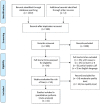Retear rates after rotator cuff surgery: a systematic review and meta-analysis
- PMID: 34465332
- PMCID: PMC8408924
- DOI: 10.1186/s12891-021-04634-6
Retear rates after rotator cuff surgery: a systematic review and meta-analysis
Abstract
Background: Rotator cuff retear (RCR) is one of the main postoperative drawbacks. RCR can be considered a multifactorial issue, which causes are related either to biological than biomechanical factors. The aim of this study was to define the incidence of RCR after surgical treatment at different time points and to identify the main factors influencing the postoperative rotator cuff (RC) healing.
Methods: A systematic review and meta-analysis were performed following the PRISMA guidelines. A comprehensive search of the literature was carried out in July 2020, using PubMed and Cochrane Library databases. Only level 1 and 2 clinical evidence studies were included. Studies were included if patients with preoperative repairable full-thickness RC tears were treated surgically, and if studies reported postoperative RCR confirmed by imaging diagnostic. The association between timing of retear and follow-up time points were investigated using an inverse-variance method of pooling data. A subgroup meta-analysis was performed using the DerSimonian and Laird method for the estimation of the between-study variance, i.e., τ2. The association between retear rate after surgery and patients' age, preoperative tear size, fatty infiltration, postoperative rehabilitation protocol, surgical techniques, and RC repairs was determined by expressing the effect measure in terms of odds ratio (OR) with 95% confidence interval (CI). The Mantel-Haenszel method with 95% CIs was used.
Results: Thirty-one articles were included in this study. The percentage of RCR after surgery was 15% at 3 months follow-up, 21% at 3-6 months follow-up, 16% at 6-12 months follow-up, 21% at 12-24 months follow-up, 16% at follow-up longer than 24 months. The main factors influencing RC healing are both patient-related (i.e., age, larger tear size, fatty infiltration) and not patient-related (i.e., postoperative rehabilitation protocol, surgical techniques, and procedures).
Conclusions: Postoperative RC healing is influenced by patient-related and non-patient-related factors. Further high-level clinical studies are needed to provide highly relevant clinical results.
Keywords: Risk factors; Rotator cuff; Rotator cuff retear; Rotator cuff tear; Timing of retear.
© 2021. The Author(s).
Conflict of interest statement
The authors declare that they have no competing interests.
Figures
References
-
- Longo UG, Ambrogioni LR, Berton A, Candela V, Carnevale A, Schena E, et al. Physical therapy and precision rehabilitation in shoulder rotator cuff disease. Int Orthop. 2020:1–11. - PubMed
Publication types
MeSH terms
LinkOut - more resources
Full Text Sources
Medical







